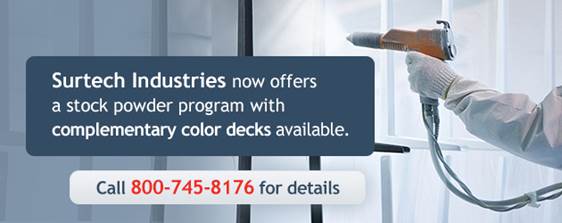
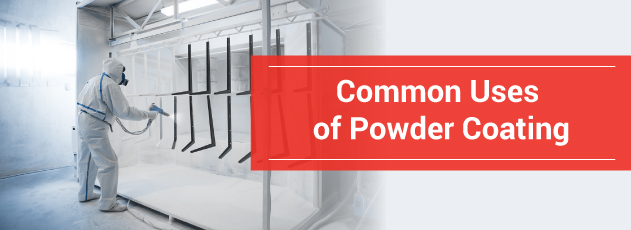
Common Uses of Powder Coating
Powder coating is one of the most popular finishing techniques available on the market today, and it’s quickly growing even more popular across industry. Experiencing approximately 6 percent growth after 2010, the powder coating market has been experiencing huge leaps in technology. It’s developing new application processes and coating formulas to expand the breadth of applications in which powder coating can be used. Between the wide range of applications and the incredible practical and financial benefits it offers, you can now find powder coating on all sorts of everyday appliances and items.
Read on to learn more about powder coating, why it is so popular and the kinds of common items that are powder coated.
What Is Powder Coating?
Powder coating is a term used to describe a particular finish or base. It starts out as a fine powder. This powder consists of finely ground particles of pigment and polymer resin. After application to a surface, the powder is chemically altered with heat to create a finishing film. The entire powder coating process occurs as follows:
- Prepare: The surface of the material goes through a thorough cleaning process to prepare for the application of the coating. Cleaning involves removing surface contaminants, and it also prepares the surface for maximum adhesion between the material and the coating. This is accomplished with a thorough cleaning, followed by etching, rinsing and material-specific cleaning processes. Typically, any issues with coatings are the result of improper preparation, rather than an issue with the coating itself.
- Attach: Depending on the application, finishers either spray the powder coating material onto a prepared surface or dip the surface into a fluid containing particles of suspended powder. In both cases, professional surface finishers make the particles bind to the item using either electricity or heat.
- Cure: After attaching the powder to the surface of the item, the item is placed in an oven, where the heat causes the particles of powder to melt, merging into a continuous film. This film can be very thin, but powder coatings tend to apply best in a thick coat.
Available since the 1950s, this method of finishing metals has seen a great deal of growth and development over the past few decades, resulting in a wide range of benefits and applications for powder coatings.
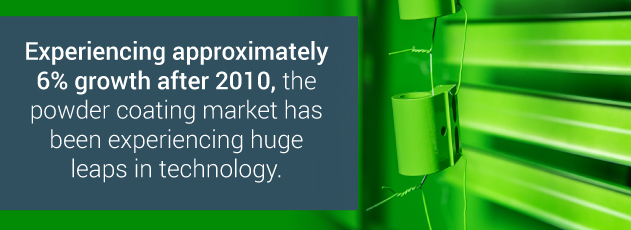
What Are the Benefits of Powder Coating?
Powder coating is applied in a unique way, and the technique lends a host of benefits and features to the application. A few of the benefits include:
- Durability: Powder coatings possess incredible resistance to abrasion and corrosion, especially compared to liquid coatings. Additionally, many companies add compounds to their powder coatings to enhance anti-corrosive or anti-abrasive properties, maintaining the quality of the coating for a longer period.
- Longevity: The quality of a powder coating lasts for years, remaining bright and vivid with less fading over a longer period. Regardless of UV radiation and use, the quality of your powder coating will remain.
- Variety: Powder coating comes in a variety of colors and finishes, all depending on the particular needs of the application. Metallic, high and low gloss and clear finishes are all possible with powder coating. While color matching is a little more difficult with powder coating than it is with liquid coating, an experienced powder coating specialist can ensure a quality coating in the correct color.
- Less Toxic: Solvent-based coatings emit volatile, often toxic compounds into the air when heated or electrified, polluting the atmosphere. It can be toxic to improperly protected workers and harmful to the environment, but it can also require more extensive air treatment and exhaust systems to clear the air. Powder coatings emit negligible amounts of toxic compounds, and up to 98 percent of the overspray released can be collected for re-use.
- Cost-Efficient: Powder coating has many benefits and requires little training and cleanup. It is an inexpensive option, especially considering the quality and durability of the product.
Powder coating isn’t perfect. Thin coats tend to be more difficult to accomplish, as are uniformly thick coats due to material movement and the effects of gravity on thicker coatings. Powder coating is also difficult to apply to sharp interior and exterior corners. These drawbacks pose problems, but the benefits far outweigh the disadvantages for most manufacturers.
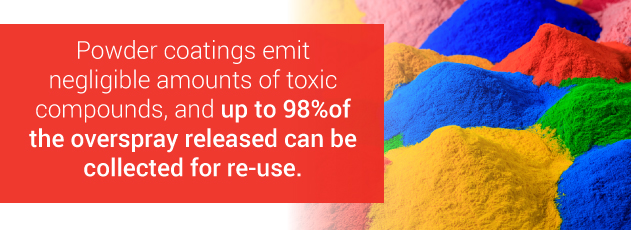
What Kinds of Items Are Powder Coated?
The benefits, especially the cost-effectiveness, of the powder coating process have made it a go-to finishing technique for applications across a variety of industries. As powder-coating processes have become more advanced and specialized, the breadth of applications has only expanded to cover more corners of the manufacturing industry.
Appliances
The appliance industry makes up the largest portion of the powder coating market, accounting for about 1/3 of all industrial powder coated parts. Powder coating is popular within this segment due to its two-fold benefit of being both aesthetically pleasing as well as resistant to abrasion and corrosion. Some of the more common appliance applications of powder coatings include:
- Ranges, Microwaves and Refrigerators: Extreme heat and cold can affect numerous paints and coatings. Powder coatings can handle a great deal of temperature cycling without wearing off or flaking. For this reason, powder coating is commonly found on oven, microwave and refrigerator panels and components.
- Vending Machines: Cooled or not, hundreds of people can use a vending machine every day. When placed outside, vending machines can take on a great deal of environmental stress. To protect their appealing exterior varnishes and help increase the lifespan of the appliance, vending machine manufacturers often finish many of their panels and components with powder coatings.
- Washers and Dryers: Standard washers and dryers used to contain parts covered with porcelain enamel, but as technology advanced and washers and dryers became more powerful, the strain on porcelain enamel-coated components proved to be too much. Now, powder coating has replaced porcelain enamel as the finishing method of choice for washers and dryers across industry.
Outdoor Products
Rough use and exposure to the elements are to be expected when you place appliances and furniture in the great outdoors. While these products are built to last in such conditions, their normal paint jobs often aren’t. Powder coating is seen in many outdoor applications, such as:
- Farm Equipment: Tractors and agricultural equipment experience hard daily use, and they are often left in the outdoors for hours. To protect their colors from the elements, such equipment is usually powder coated, providing a durable finish that will last for years in even the harshest conditions.
- Sports Equipment: From golf clubs and ski poles to bicycles and basketball hoops, outdoor sports put equipment to the test. In rain or shine, powder coating provides a quality finish that can stand up to hard use and nasty weather.
- Outdoor Furniture: Everything from playground and park equipment to lawn chairs use powder coating. The finish provides an aesthetically pleasing look and helps to protect the equipment from corrosion, no matter how many years the fixtures spend in the baking sun and unforgiving cold.
- Signs: Signs are crucial to public spaces, providing directions and instructions for automotive and pedestrian traffic and promoting for businesses. A worn-out sign causes confusion, and it can lead to automotive accidents and lost business. To help avoid this, many signs are finished or primed with powder coating to increase their lifespan of legibility.
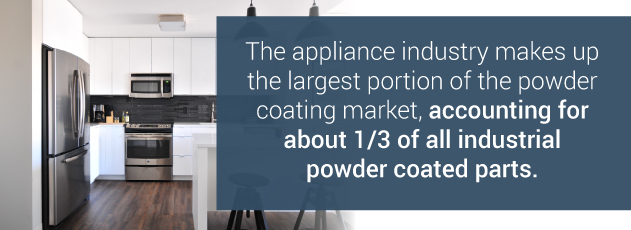
Architecture and Construction
One of the fastest growing markets for powder coating is the architectural and building market, primarily due to the durability provided by powder coatings. With the wide variety of colors and finishes available in powder coatings, more and more construction companies are turning to powder coatings to provide long-term exterior finishes for outdoor venues and public works projects. Some of the most common applications for powder coatings in construction include:
- Stadiums: With exposure to the sun’s UV rays and frequent use by visitors, stadium seating for outdoor venues is prone to quite a bit of wear and tear. To help protect seating while maintaining high-quality color, many architects finish their stadium seats and handles with a powder coating finish.
- Windows and Doors: Extruded aluminum door and window frames and doorknobs are commonly finished with powder coatings. The finish helps protect the materials from harsh weather conditions, but it also helps maintain colors and finishes no matter how many hands touch them or how many storms they weather.
- Fencing and Poles: For both public and private property, fences and poles for signage, property protection and structural support need to maintain aesthetic appeal while warding off corrosion. You can accomplish both goals with a powder finish.
- Building Facades: Industrial buildings and modern structures often feature metal components or facades, facing weather conditions from rain and snow to unforgiving heat. Most paints will crack or peel or otherwise degrade under severe conditions, but not powder coating. For a quality color that stands the test of time, architects working with metal facades often turn to powder coating.
Automotive Items
Powder coating is commonly used throughout the automotive industry as both a basecoat and a finish for a variety of automotive components. Some of the more specific applications of powder coating include:
- Surface Primer: Numerous luxury and sports car manufacturers use powder as an intermediate coat on certain car models. Door handles, trims and bumpers are especially popular subjects for powder coating, as they tend to undergo more stress, therefore requiring more protection and coat bonding. It’s also popular as a base coating for sports vehicles like ATVs and snowmobiles.
- Under-hood Components: Break components, radiators, shock absorbers, oil filters, battery trays and coil springs are all interior automotive components. Heat, stress and elemental wear and tear all contribute to these parts wearing down and corroding over time. Powder coating helps protect these components and extend their lives in even the harshest conditions.
- Wheels: Wheels and hubcaps are exposed to the brunt of a car’s elemental stress. Water, snow, ice and the occasional scrape against the curb can all contribute to the wheel’s color and finish wearing down over time. Powder coatings provide additional protection from the elements, and they’re gaining popularity among specialty and alloy wheel manufacturers.
- Motorbike Frames: Motorized bikes, especially those meant for extreme sports, undergo daily stresses that typical paints can’t survive. Instead, they are powder coated, providing either a colored finish or a base coat for another finishing technique, effectively extending the lifespan of the motorbike’s outer layer.
- Public Transportation: Hundreds of people touch the bars and handles inside of a bus or train on a daily basis, and therefore are more prone to wear and tear. Powder coatings help protect these parts, preserving their color and finish for years.
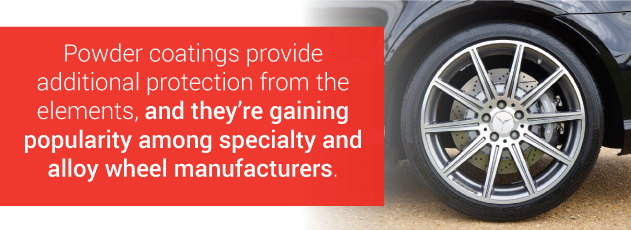
General Items
With the advent of new techniques and cost-effective finishing methods, more materials and products than ever are being finished with powder coating. Even plastics and woods can be finished using powder coating, thanks to new low-temperature powder application procedures. Some of the other everyday items that are powder coated include:
- Fire Extinguishers: Fire extinguishers are coated in thermally stable powder coating that will retain its red color and protect the extinguisher housing in brutally hot conditions.
- Electronics: Electronic housings, wires and more benefit from powder coatings, which are often modified with electroconductive or electrodissipative properties to improve the function and safety of the product.
- Office Supplies: Thumbtacks, electronic pencils and even shelving often use powder coating as an anti-corrosive protecting agent. Some supplies are even protected with specially designed coatings. For example, many metal shelving installations use modified powder-coating recipes to protect the surface from abrasion.
Where Can You Find a Quality Powder Coating Service in PA?
If you’re looking for a high-quality industrial powder coating company in central PA, Surtech Industries is the best in the business. With over 30 years of experience in industrial powder coating services, Surtech Industries knows powder coating inside and out. Our two automated powder coating application systems are top-of-the-line pieces of equipment, providing the highest quality coatings possible, while our variety of coating formulations offer various physical and aesthetic attributes. We guarantee you the best coating possible, providing you with performance testing at the highest standards.
For more information about powder coating or the variety of finishing services available today, explore our website or contact Surtech Industries. Ready to partner with the best powder coating company in central PA? Get a free powder coating quote.
Contact Us!
- Address:
- 915 Borom Rd.
York, PA17404 - Phone:
- 717-767-6808
1-800-745-8176 - Online:
- Contact Us to request a free quote!
- Employee Directory:
- View our Employee Directory.